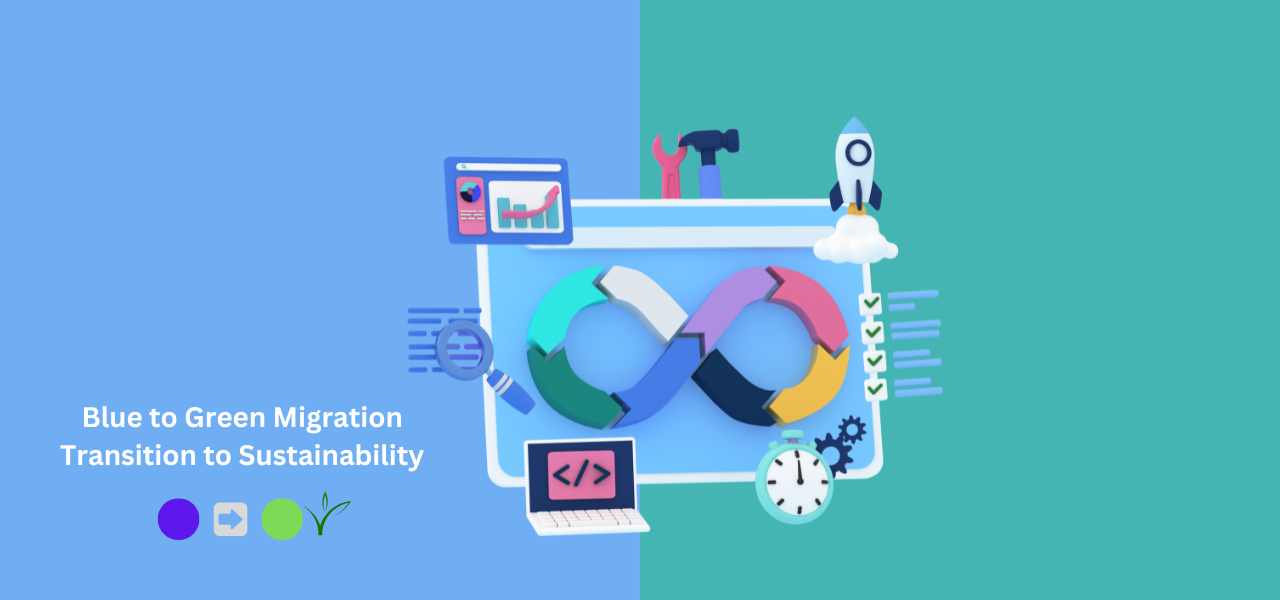Green DevOps and Blue to Green Migration: Simplifying Complexity with Emerging Technologies 🌱🔄

Businesses are constantly seeking ways to stay ahead by optimizing processes, cutting costs, and enhancing sustainability. Enter Green DevOps and Blue to Green Migration—two transformative strategies reshaping how organizations develop, deploy, and maintain software. While these terms might sound complex, emerging technologies are making them more accessible and impactful than ever before. Let’s explore these concepts, their challenges, and how modern tools simplify the journey toward a sustainable and efficient future. 🌍✨
What is Green DevOps? 🌿💻
Imagine a world where your software development processes not only deliver results quickly but do so with minimal environmental impact. That’s the essence of Green DevOps—a fusion of sustainable computing and agile DevOps practices. The goal? Minimize carbon footprints, optimize resource usage, and build systems that are energy-efficient without sacrificing speed or flexibility.
Key Principles of Green DevOps:
- 🌱 Resource Efficiency: Optimize computing resources to reduce energy consumption.
- 🔋 Sustainable Infrastructure: Use cloud providers and data centers powered by renewable energy.
- ⚙️ Automated Optimization: Leverage automation to minimize waste and enhance deployment pipeline efficiency.
- 📊 Continuous Improvement: Incorporate sustainability into feedback loops to enhance energy efficiency over time.
With Green DevOps, businesses can deliver high-performance applications while contributing to a greener planet.
Blue to Green Migration: Transitioning to Sustainability 🔷➔🟢
The Blue to Green Migration strategy involves transitioning from legacy systems (the “blue” environment) to modern, sustainable systems (the “green” environment). This transformation is vital for businesses looking to upgrade infrastructure with minimal disruption while maximizing sustainability.
The Migration Process:
- 🔄 Setting up the Green Environment: Establish the new, optimized infrastructure.
- 📦 Data Migration: Transfer data securely and accurately from the legacy system.
- ⚒️ Testing: Ensure the green system meets or exceeds the performance of the blue system.
- 🔄 Switching Over: Transition operations to the green environment with minimal downtime.
Although it may seem daunting, modern technologies significantly simplify this process, making it smoother and more reliable.
Challenges in Migration and Sustainability ⚙️🤔
Migrating from blue to green environments presents several challenges:
- ⏳ Minimizing Downtime: Ensuring seamless transitions without disrupting operations.
- 📊 Data Integrity: Safeguarding accuracy and consistency during large-scale data transfers.
- 💡 Resource Management: Ensuring the green environment is energy-efficient and resource-optimized.
Addressing these challenges requires robust planning and the right tools to balance performance and sustainability goals.
How Emerging Technologies Simplify the Transition 🛠️🌐
Modern tools and innovations are revolutionizing Green DevOps and Blue to Green Migration, making them more efficient and practical. Here’s how:
Cloud-Native Solutions ☁️
Cloud platforms like AWS, Azure, and Google Cloud enable:
- ⚡ Serverless Computing: Pay only for resources used, reducing waste.
- 🔧 Seamless Migration: Tools for transitioning without downtime.
- 🔒 Managed Services: Offload infrastructure management to optimize energy and resources.
Containerization and Kubernetes 🐳🔦
Containers streamline deployments and optimize resource usage:
- 🔻 Lightweight Applications: Require less computational power, saving energy.
- ⚙️ Microservices Architecture: Fine-tune resource allocation for greater efficiency.
- ⌚ Automation with Kubernetes: Ensures green environments run optimally without unnecessary energy consumption.
Automation Tools for DevOps and Migration 🤖↻
Automation accelerates and enhances migration processes:
- 🔧 Automated Testing and Deployment: Reduces manual effort and errors.
- 🌍 Infrastructure as Code (IaC): Tools like Terraform automate infrastructure provisioning, minimizing resource waste.
AI and Machine Learning for Optimization 🤖🌱
AI-driven solutions revolutionize resource management:
- 🔋 Energy Optimization: Dynamically manage energy use in data centers.
- ⚙️ Predictive Analytics: Anticipate and address migration issues proactively.
Monitoring and Analytics Tools 📊🔍
Real-time tracking tools help:
- 🌱 Measure Sustainability Metrics: Ensure green goals are met.
- 🔧 Identify Inefficiencies: Optimize operations for maximum resource efficiency.
The Future: Sustainable and Efficient Systems 🌍🔬
With Green DevOps and simplified Blue to Green Migration processes, businesses can now build scalable, sustainable systems without compromising performance. These strategies are not just technical upgrades but strategic moves toward an eco-friendly and efficient future.
By embracing these innovations, organizations can lead the charge in building systems that are innovative and kind to the planet. The power of technology is in your hands—embrace it to elevate your business and create a sustainable legacy. 🌱🚀




